E-Commerce Development: Strategies, SWOT, and Online Selling
VerifiedAdded on 2023/06/08
|6
|860
|232
Report
AI Summary
This report provides a comprehensive overview of the e-commerce development process, encompassing key aspects such as product and customer identification, platform selection, testing, and effective marketing strategies. It delves into revenue models, emphasizing their role in managing revenue streams and resources, alongside a detailed market and SWOT analysis to determine market attractiveness and understand potential threats and opportunities. The report also highlights the impact of e-commerce on the global economy and the crucial role of the internet, web servers, and email technologies in boosting online business. Furthermore, it outlines various e-commerce models, the importance of online selling, and the role of virtual communities in fostering customer communication and support. The document is available on Desklib, a platform offering a wealth of study resources for students.
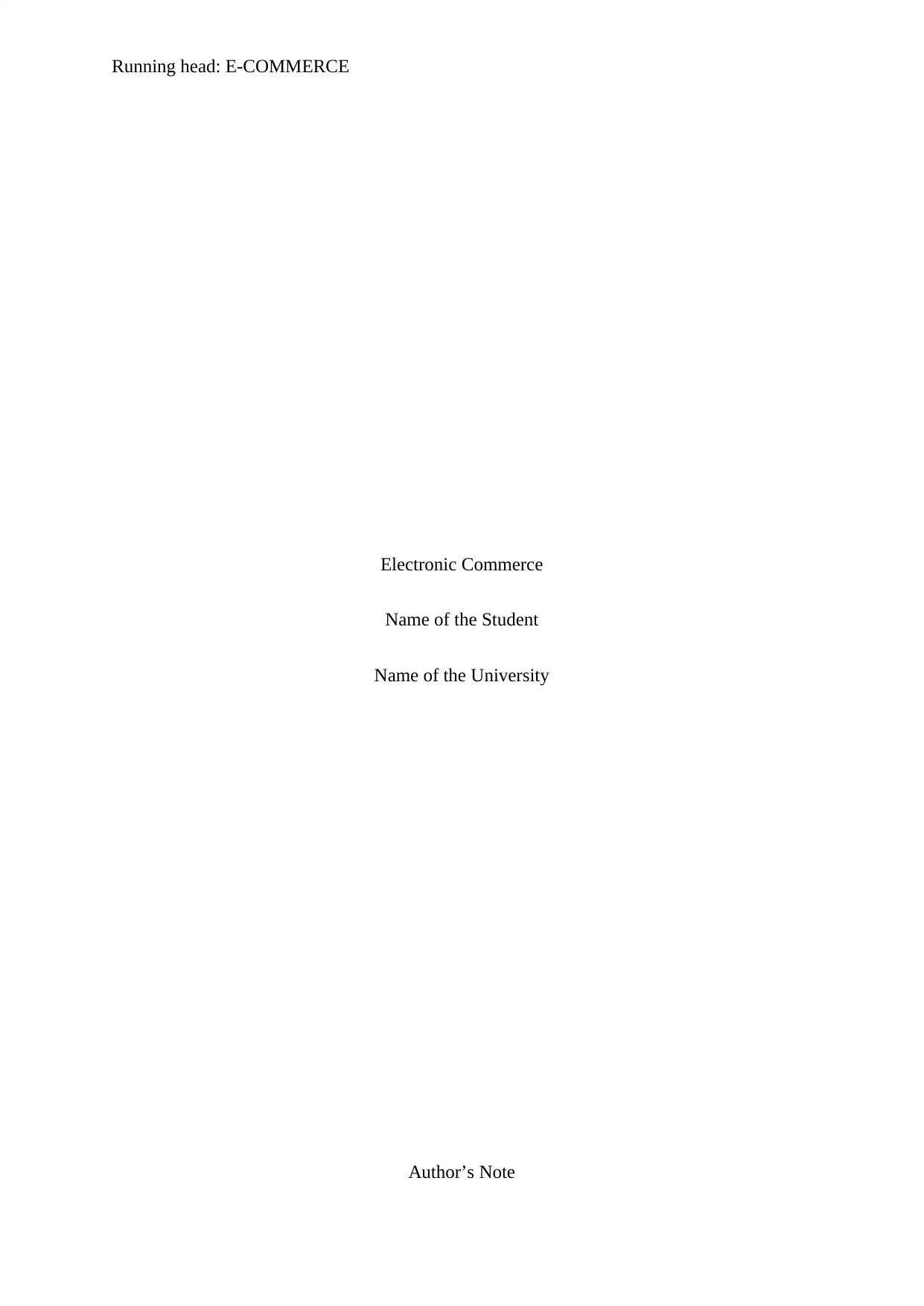
Running head: E-COMMERCE
Electronic Commerce
Name of the Student
Name of the University
Author’s Note
Electronic Commerce
Name of the Student
Name of the University
Author’s Note
Paraphrase This Document
Need a fresh take? Get an instant paraphrase of this document with our AI Paraphraser
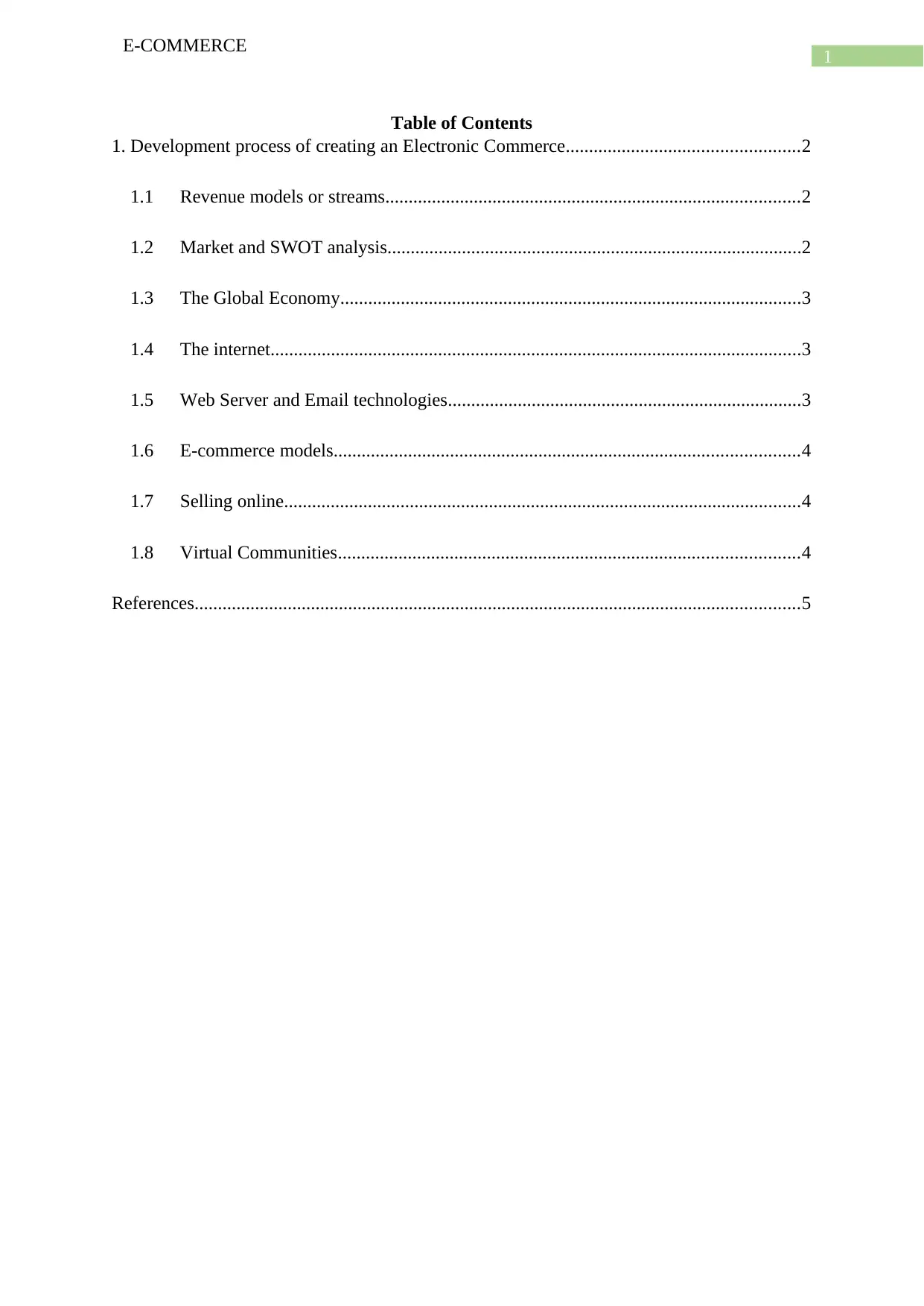
1
E-COMMERCE
Table of Contents
1. Development process of creating an Electronic Commerce..................................................2
1.1 Revenue models or streams.........................................................................................2
1.2 Market and SWOT analysis.........................................................................................2
1.3 The Global Economy...................................................................................................3
1.4 The internet..................................................................................................................3
1.5 Web Server and Email technologies............................................................................3
1.6 E-commerce models....................................................................................................4
1.7 Selling online...............................................................................................................4
1.8 Virtual Communities...................................................................................................4
References..................................................................................................................................5
E-COMMERCE
Table of Contents
1. Development process of creating an Electronic Commerce..................................................2
1.1 Revenue models or streams.........................................................................................2
1.2 Market and SWOT analysis.........................................................................................2
1.3 The Global Economy...................................................................................................3
1.4 The internet..................................................................................................................3
1.5 Web Server and Email technologies............................................................................3
1.6 E-commerce models....................................................................................................4
1.7 Selling online...............................................................................................................4
1.8 Virtual Communities...................................................................................................4
References..................................................................................................................................5
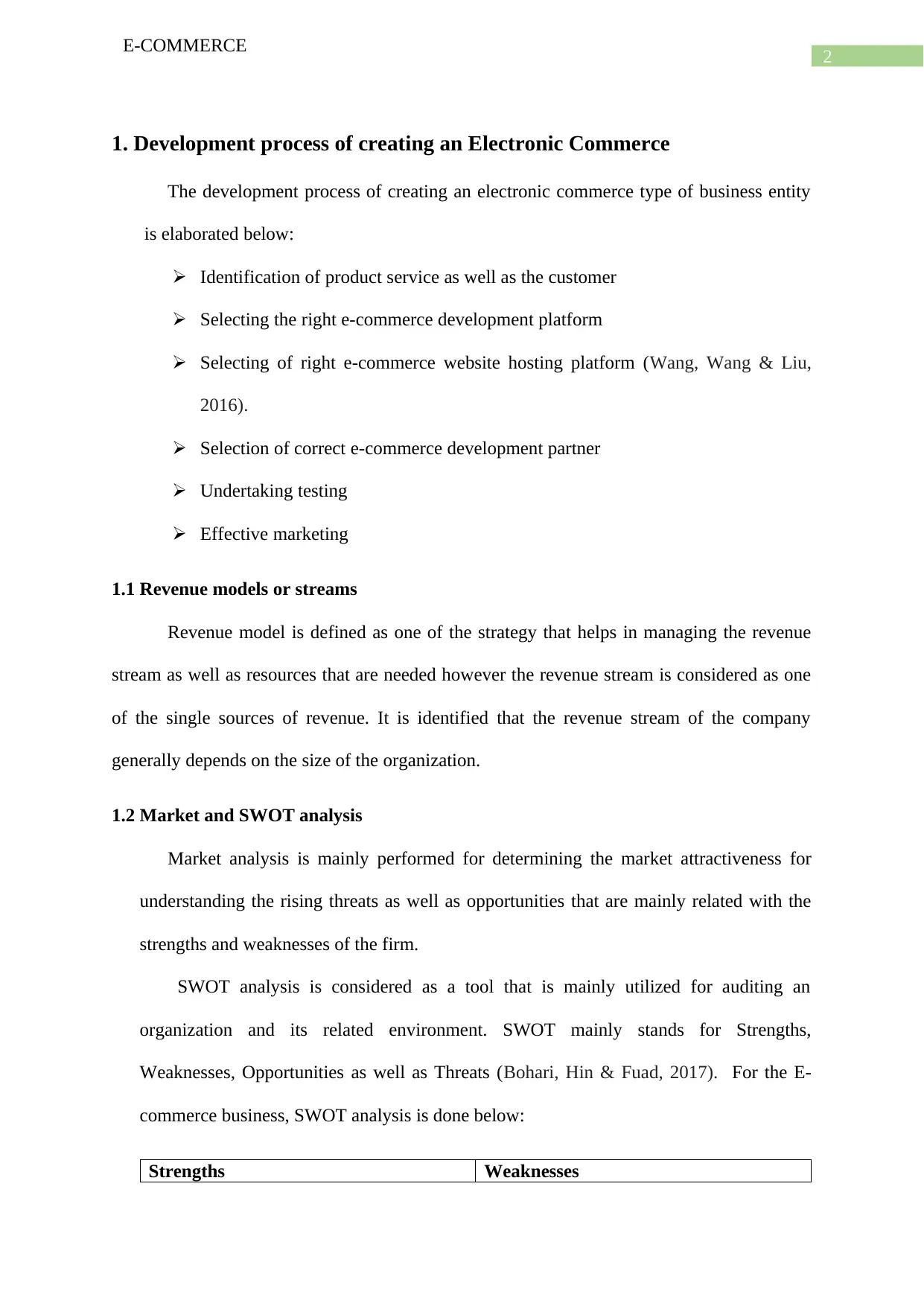
2
E-COMMERCE
1. Development process of creating an Electronic Commerce
The development process of creating an electronic commerce type of business entity
is elaborated below:
Identification of product service as well as the customer
Selecting the right e-commerce development platform
Selecting of right e-commerce website hosting platform (Wang, Wang & Liu,
2016).
Selection of correct e-commerce development partner
Undertaking testing
Effective marketing
1.1 Revenue models or streams
Revenue model is defined as one of the strategy that helps in managing the revenue
stream as well as resources that are needed however the revenue stream is considered as one
of the single sources of revenue. It is identified that the revenue stream of the company
generally depends on the size of the organization.
1.2 Market and SWOT analysis
Market analysis is mainly performed for determining the market attractiveness for
understanding the rising threats as well as opportunities that are mainly related with the
strengths and weaknesses of the firm.
SWOT analysis is considered as a tool that is mainly utilized for auditing an
organization and its related environment. SWOT mainly stands for Strengths,
Weaknesses, Opportunities as well as Threats (Bohari, Hin & Fuad, 2017). For the E-
commerce business, SWOT analysis is done below:
Strengths Weaknesses
E-COMMERCE
1. Development process of creating an Electronic Commerce
The development process of creating an electronic commerce type of business entity
is elaborated below:
Identification of product service as well as the customer
Selecting the right e-commerce development platform
Selecting of right e-commerce website hosting platform (Wang, Wang & Liu,
2016).
Selection of correct e-commerce development partner
Undertaking testing
Effective marketing
1.1 Revenue models or streams
Revenue model is defined as one of the strategy that helps in managing the revenue
stream as well as resources that are needed however the revenue stream is considered as one
of the single sources of revenue. It is identified that the revenue stream of the company
generally depends on the size of the organization.
1.2 Market and SWOT analysis
Market analysis is mainly performed for determining the market attractiveness for
understanding the rising threats as well as opportunities that are mainly related with the
strengths and weaknesses of the firm.
SWOT analysis is considered as a tool that is mainly utilized for auditing an
organization and its related environment. SWOT mainly stands for Strengths,
Weaknesses, Opportunities as well as Threats (Bohari, Hin & Fuad, 2017). For the E-
commerce business, SWOT analysis is done below:
Strengths Weaknesses
⊘ This is a preview!⊘
Do you want full access?
Subscribe today to unlock all pages.

Trusted by 1+ million students worldwide
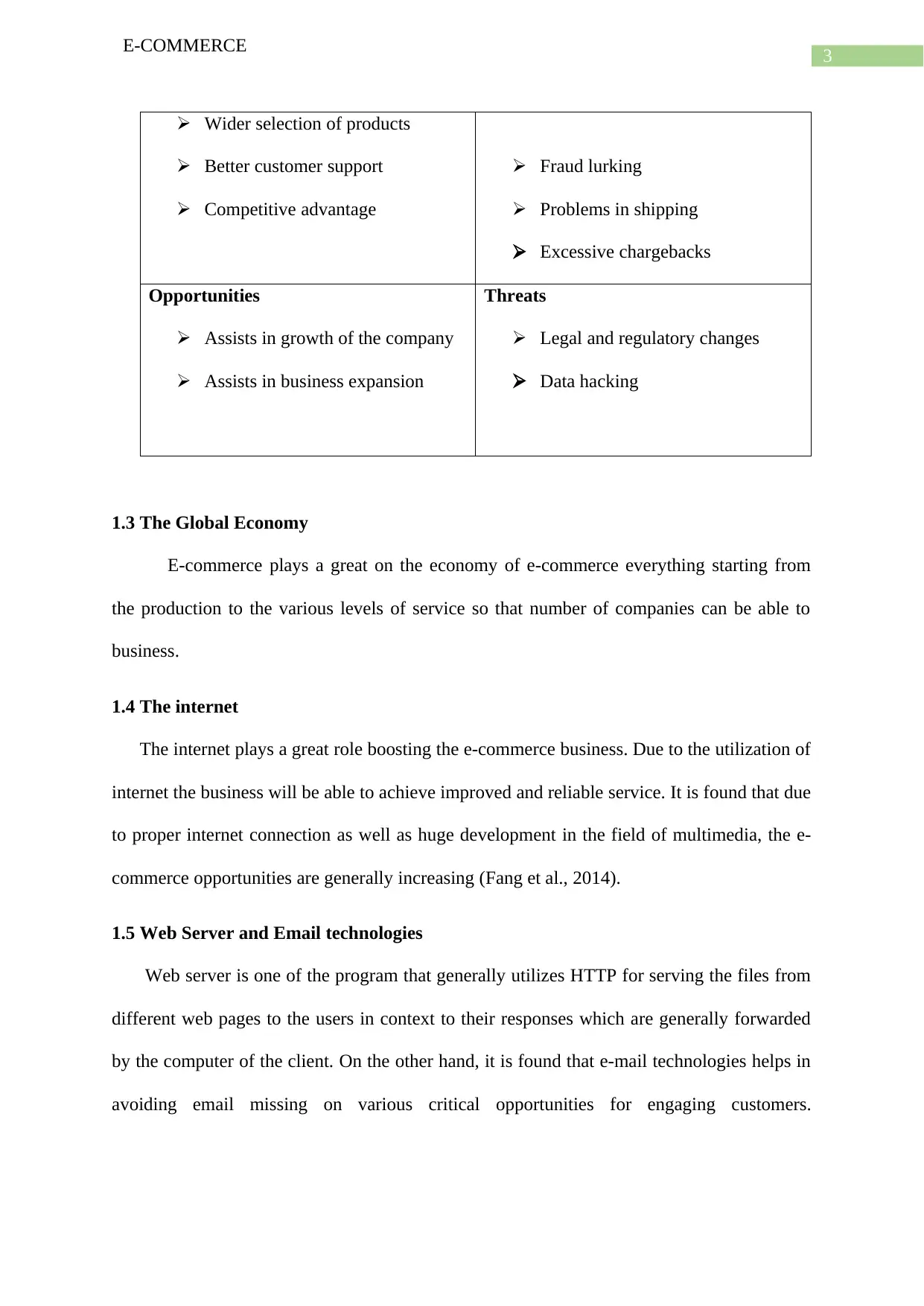
3
E-COMMERCE
Wider selection of products
Better customer support
Competitive advantage
Fraud lurking
Problems in shipping
Excessive chargebacks
Opportunities
Assists in growth of the company
Assists in business expansion
Threats
Legal and regulatory changes
Data hacking
1.3 The Global Economy
E-commerce plays a great on the economy of e-commerce everything starting from
the production to the various levels of service so that number of companies can be able to
business.
1.4 The internet
The internet plays a great role boosting the e-commerce business. Due to the utilization of
internet the business will be able to achieve improved and reliable service. It is found that due
to proper internet connection as well as huge development in the field of multimedia, the e-
commerce opportunities are generally increasing (Fang et al., 2014).
1.5 Web Server and Email technologies
Web server is one of the program that generally utilizes HTTP for serving the files from
different web pages to the users in context to their responses which are generally forwarded
by the computer of the client. On the other hand, it is found that e-mail technologies helps in
avoiding email missing on various critical opportunities for engaging customers.
E-COMMERCE
Wider selection of products
Better customer support
Competitive advantage
Fraud lurking
Problems in shipping
Excessive chargebacks
Opportunities
Assists in growth of the company
Assists in business expansion
Threats
Legal and regulatory changes
Data hacking
1.3 The Global Economy
E-commerce plays a great on the economy of e-commerce everything starting from
the production to the various levels of service so that number of companies can be able to
business.
1.4 The internet
The internet plays a great role boosting the e-commerce business. Due to the utilization of
internet the business will be able to achieve improved and reliable service. It is found that due
to proper internet connection as well as huge development in the field of multimedia, the e-
commerce opportunities are generally increasing (Fang et al., 2014).
1.5 Web Server and Email technologies
Web server is one of the program that generally utilizes HTTP for serving the files from
different web pages to the users in context to their responses which are generally forwarded
by the computer of the client. On the other hand, it is found that e-mail technologies helps in
avoiding email missing on various critical opportunities for engaging customers.
Paraphrase This Document
Need a fresh take? Get an instant paraphrase of this document with our AI Paraphraser
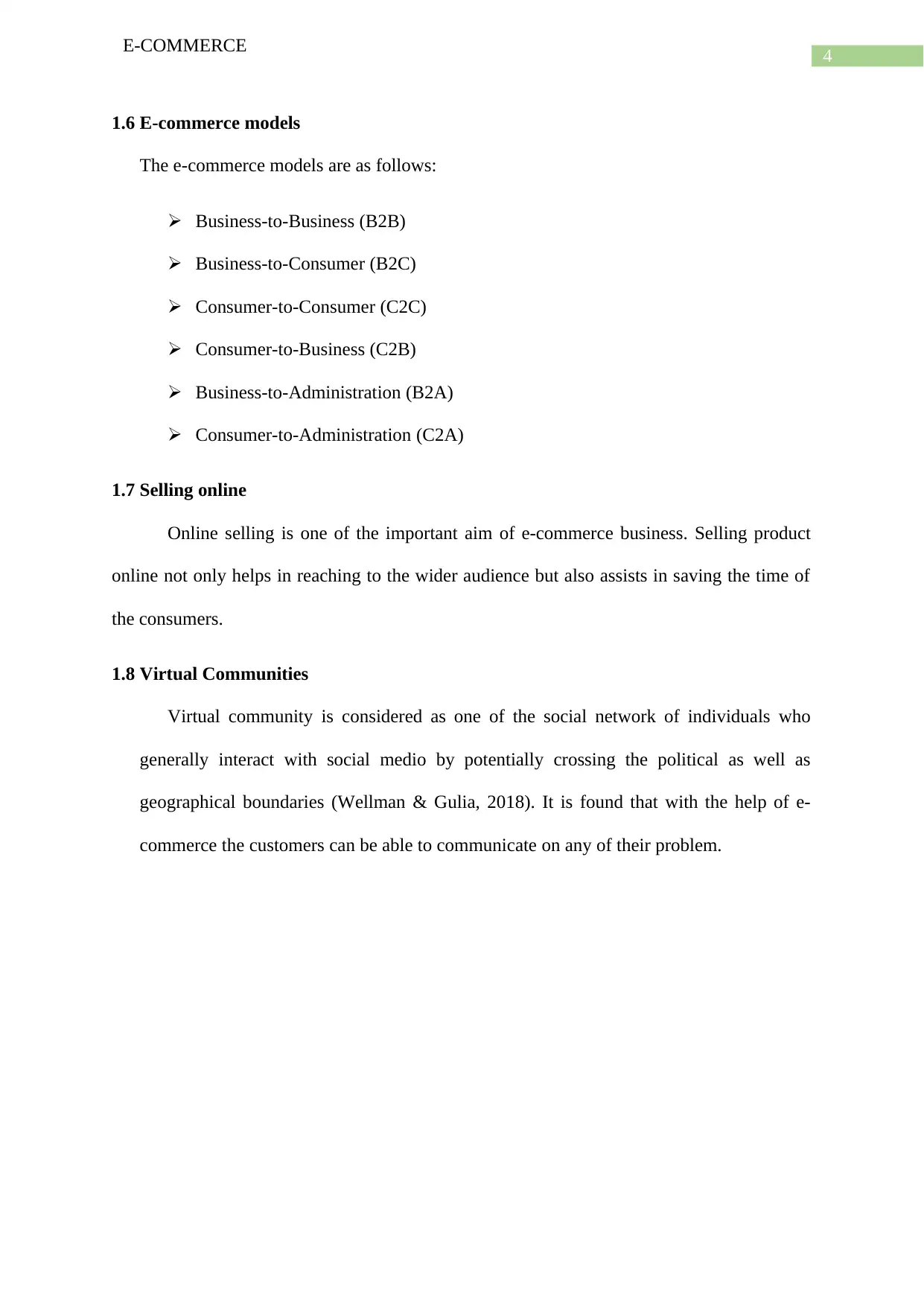
4
E-COMMERCE
1.6 E-commerce models
The e-commerce models are as follows:
Business-to-Business (B2B)
Business-to-Consumer (B2C)
Consumer-to-Consumer (C2C)
Consumer-to-Business (C2B)
Business-to-Administration (B2A)
Consumer-to-Administration (C2A)
1.7 Selling online
Online selling is one of the important aim of e-commerce business. Selling product
online not only helps in reaching to the wider audience but also assists in saving the time of
the consumers.
1.8 Virtual Communities
Virtual community is considered as one of the social network of individuals who
generally interact with social medio by potentially crossing the political as well as
geographical boundaries (Wellman & Gulia, 2018). It is found that with the help of e-
commerce the customers can be able to communicate on any of their problem.
E-COMMERCE
1.6 E-commerce models
The e-commerce models are as follows:
Business-to-Business (B2B)
Business-to-Consumer (B2C)
Consumer-to-Consumer (C2C)
Consumer-to-Business (C2B)
Business-to-Administration (B2A)
Consumer-to-Administration (C2A)
1.7 Selling online
Online selling is one of the important aim of e-commerce business. Selling product
online not only helps in reaching to the wider audience but also assists in saving the time of
the consumers.
1.8 Virtual Communities
Virtual community is considered as one of the social network of individuals who
generally interact with social medio by potentially crossing the political as well as
geographical boundaries (Wellman & Gulia, 2018). It is found that with the help of e-
commerce the customers can be able to communicate on any of their problem.
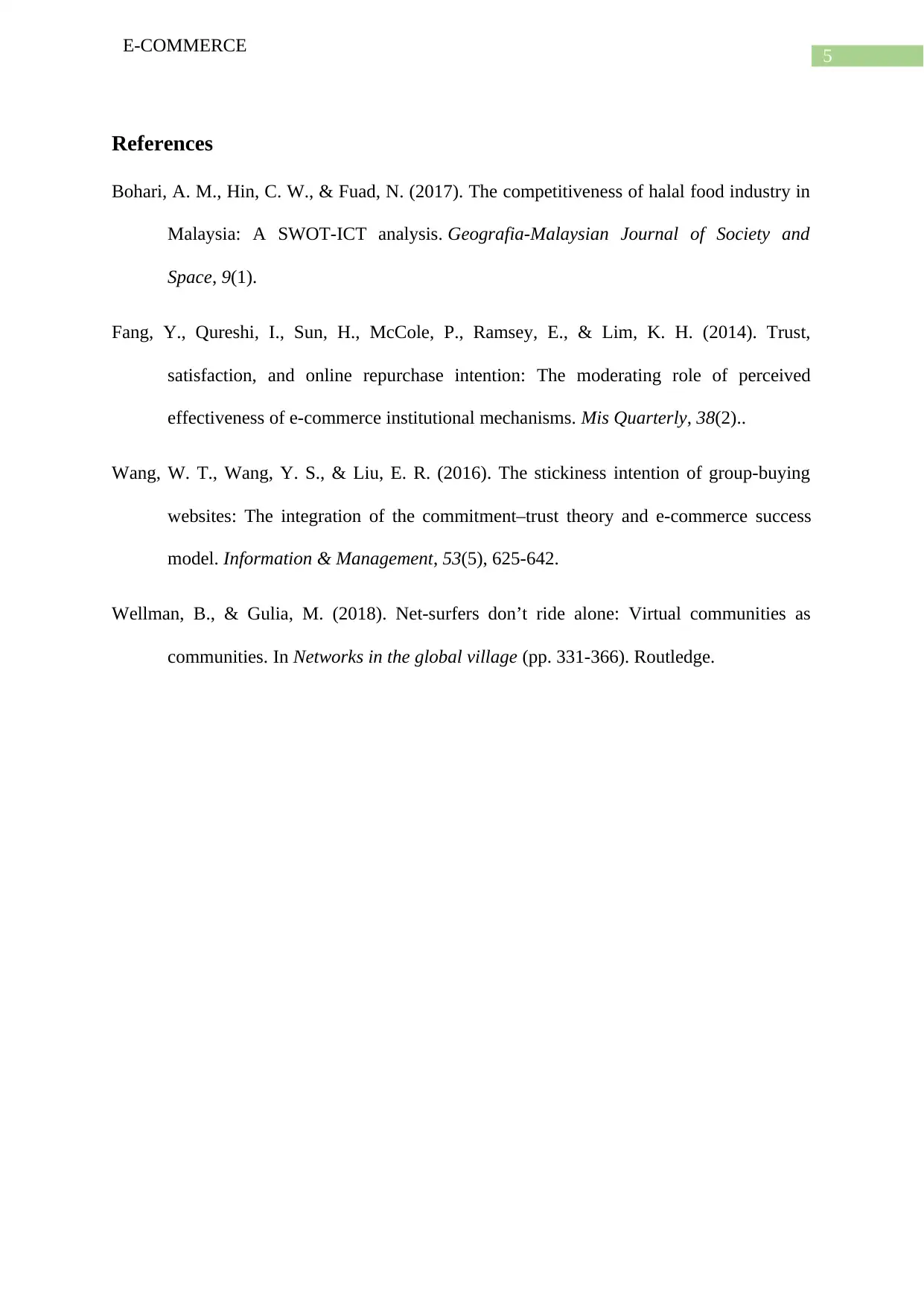
5
E-COMMERCE
References
Bohari, A. M., Hin, C. W., & Fuad, N. (2017). The competitiveness of halal food industry in
Malaysia: A SWOT-ICT analysis. Geografia-Malaysian Journal of Society and
Space, 9(1).
Fang, Y., Qureshi, I., Sun, H., McCole, P., Ramsey, E., & Lim, K. H. (2014). Trust,
satisfaction, and online repurchase intention: The moderating role of perceived
effectiveness of e-commerce institutional mechanisms. Mis Quarterly, 38(2)..
Wang, W. T., Wang, Y. S., & Liu, E. R. (2016). The stickiness intention of group-buying
websites: The integration of the commitment–trust theory and e-commerce success
model. Information & Management, 53(5), 625-642.
Wellman, B., & Gulia, M. (2018). Net-surfers don’t ride alone: Virtual communities as
communities. In Networks in the global village (pp. 331-366). Routledge.
E-COMMERCE
References
Bohari, A. M., Hin, C. W., & Fuad, N. (2017). The competitiveness of halal food industry in
Malaysia: A SWOT-ICT analysis. Geografia-Malaysian Journal of Society and
Space, 9(1).
Fang, Y., Qureshi, I., Sun, H., McCole, P., Ramsey, E., & Lim, K. H. (2014). Trust,
satisfaction, and online repurchase intention: The moderating role of perceived
effectiveness of e-commerce institutional mechanisms. Mis Quarterly, 38(2)..
Wang, W. T., Wang, Y. S., & Liu, E. R. (2016). The stickiness intention of group-buying
websites: The integration of the commitment–trust theory and e-commerce success
model. Information & Management, 53(5), 625-642.
Wellman, B., & Gulia, M. (2018). Net-surfers don’t ride alone: Virtual communities as
communities. In Networks in the global village (pp. 331-366). Routledge.
⊘ This is a preview!⊘
Do you want full access?
Subscribe today to unlock all pages.

Trusted by 1+ million students worldwide
1 out of 6
Related Documents
Your All-in-One AI-Powered Toolkit for Academic Success.
+13062052269
info@desklib.com
Available 24*7 on WhatsApp / Email
![[object Object]](/_next/static/media/star-bottom.7253800d.svg)
Unlock your academic potential
Copyright © 2020–2025 A2Z Services. All Rights Reserved. Developed and managed by ZUCOL.





